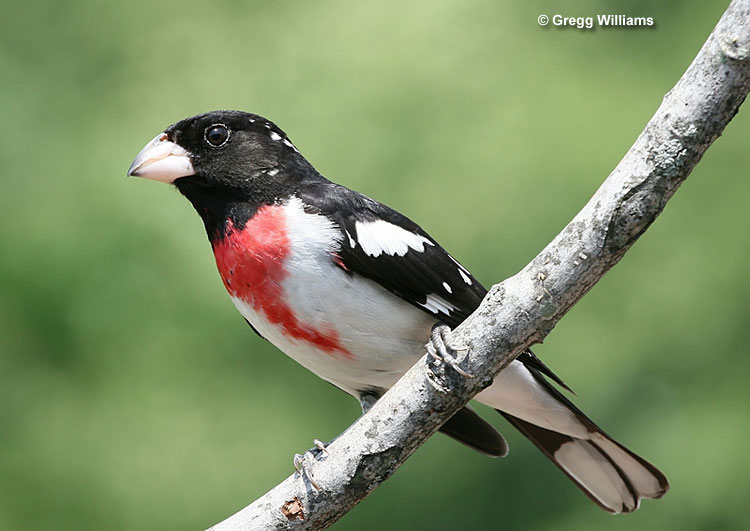Rose-breasted Grosbeaks (Pheucticus ludovicianus) are striking medium-sized songbirds. Males boast a combination of black-and-white plumage with the red triangular patch on their throat earning them the nickname ‘cut-throats’ while females sport a more subdued brown and buffy appearance.
Their sweet warbling songs fill the woodlands and other semi-open habitats across Canada and the northeastern United States. Here is all you need to know about them.
Identification
Rose-breasted Grosbeaks are medium-sized songbirds, measuring 7.1-8.7 inches long with a wingspan of 11-13 inches. Females are generally smaller than males.
Their body build is similar to that of sparrows. They are stocky, broad-chested, have a fairly short neck, and a medium-length tail that is squared off at the end. Both sexes have black eyes, dark legs, and large pinkish triangular bills.
Male
Male Rose-breasted Grosbeaks are a stunning combination of black, white, and red. They are mostly black above and white below. Their heads and throats are also black, and they have white spots on their wings and tails. If you happen to glance a look at them from behind, you will see that they have a big white patch on their rumps.
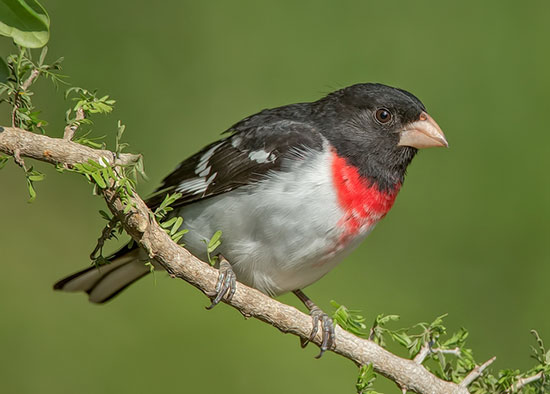
As the name suggests, they have a bright red triangular patch on their chests. When they are flying, you can see that they have pinkish-red wing linings.
Female
Female Rose-breasted Grosbeaks are mostly dark brown above and warm pale buffy below. They are streaked above and have short dark brown streaks on their throats, chests, and flanks.

Their face is pale brown, they have a brown cap and a white stripe above the eye. Similarly to males, they have white spots on their wings and tails, albeit smaller. In flight, they have yellow wing linings instead of reddish ones.
Juvenile Rose-breasted Grosbeaks look similar to females. Immature males are slightly different, however, taking characteristics from both male and female plumage.
Overall, they have the male plumage, but the red on their breast is duller and smaller, they have some dark streaking on their throats and flanks, and they have a white line above their eye.
Vocalizations
The song of Rose-breasted Grosbeaks is a rich, sweet, slowly whistled warbling. It lasts for around 6 seconds and consists of roughly 20 notes that alternately rise and fall in pitch.
Both males and females sing, although at different times and for different purposes. Females sing when they build their nest, incubate, or brood their young. On the other hand, males start singing earlier, even on the wintering grounds, and sing from high perches or quietly when on the nest. The grosbeaks seem to learn their songs.
Rose-breasted Grosbeaks call with a sharp and high-pitched chink– or pick-note. It resembles the sound of a sneaker squeaking against the gym floor. Other calls include metallic eek-eek sounds, repeated squawks, chuks, and hurrs. Immature birds call with high-pitched and slightly sad-sounding teyoo and turlee notes.
Food
Rose-breasted Grosbeaks are omnivores with the specific ratios and contents of their diet varying seasonally and depending on what is available. They consume more animal matter during the breeding season and plant matter during fall and winter. Young birds are mainly fed insects.
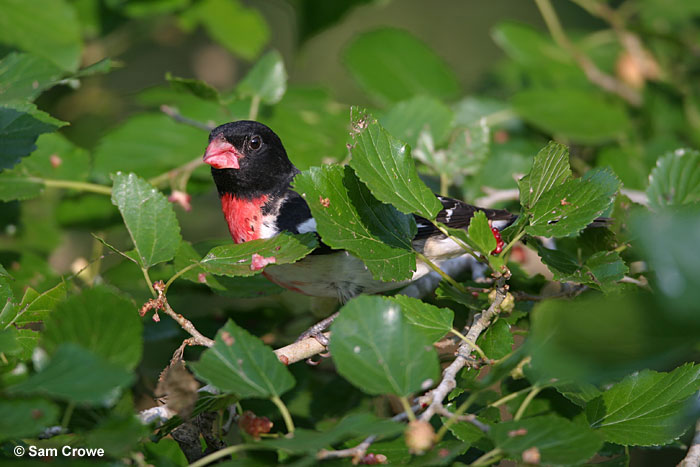
The animal part of their diet mainly consists of various insects and other invertebrates. This includes beetles, ants, bees, bugs, butterflies, moths, caterpillars, grasshoppers, spiders, snails, sawflies, and larvae. The plant part of their diet consists of wild fruit and berries, including red-berried elders, elderberries, raspberries, blackberries, mulberries, and juneberries.
They also eat seeds from various plants and weeds such as from smartweed, milkweed, pigweed, foxtail, and sunflowers. Buds and flowers and crops, including peas, oats, corn, and wheat are also consumed.
Rose-breasted Grosbeaks mostly forage amidst the lush foliage and canopy of shrubs and trees, with occasional ventures to the ground.
Skillfully navigating the branches, they deftly pick prey from the bark or leaves. At times, they may also hover to pluck insects from foliage or bark. You may also see them dark into the air to capture insects mid-flight.
Nesting and Eggs
Rose-breasted Grosbeaks are mostly monogamous. The birds form pairs in the spring on the breeding grounds.
Males first establish and defend a territory by singing, which is also meant to attract potential mates. Females approach the territories of singing males, to which males may react aggressively at first. Courtship displays include rapid warbling and flying and males spreading their wings and tails while approaching the female.
Rose-breasted Grosbeaks nest in vertical forks or crotches of mostly deciduous trees, vines, or shrubs roughly 5-20 feet above the ground. You may find their nests in forest openings, old pastures, gardens, parks, overgrown field edges, along shrubby roads, and also in residential areas. Females are usually the ones choosing the nesting site and doing the building.
The open cup is loosely woven of twigs, grasses, weeds, and leaves and lined with finer materials such as fine grasses, pine needles, shredded bark, and fur. It measures between 3.5 to 9 inches in diameter and 1.5 to 5 inches in height.
One pair can have up to two broods in a year with 1-5, typically 4 eggs in a clutch. Rose-breasted Grosbeak eggs are pale greenish blue and speckled with purplish or reddish-brown spots. They measure 0.8-1.1 inches long and 0.6-0.8 inches wide. Incubation takes 11-14 days with both parents taking turns.
They also take turns brooding the young and feeding them. Young fledge and leave the nest at 9-12 days after hatching and become independent roughly 3 weeks after that.
Current Situation
Rose-breasted Grosbeaks range across most of North and Central America and northernmost South America. Their breeding range extends across most of Canada and the northeastern United States. The birds migrate to southern Central America and northern South America for the winter.
Rose-breasted Grosbeaks inhabit moist or riparian woodlands, thickets, and other semi-open habitats.
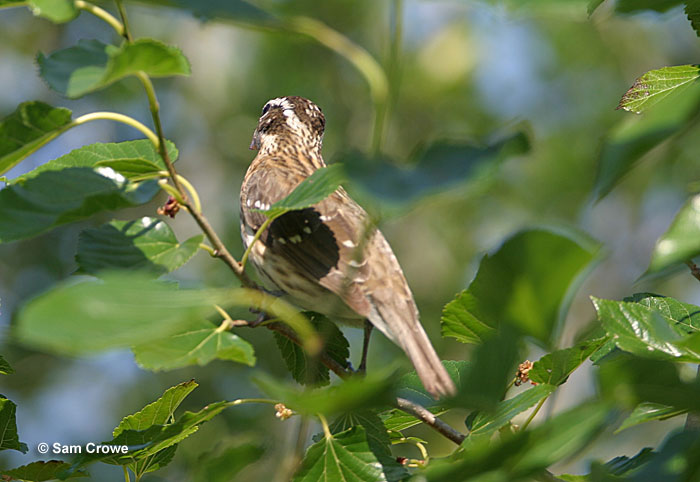
They prefer deciduous or mixed woods with a combination of tall trees and shrubby understory, suburban areas, gardens, orchards, and parks but can also be found in marshes along roadsides, and pastures. During migration, they may be seen in almost any kind of semi-open or wooded areas, but they avoid dry woodlands and grasslands.
Rose-breasted Grosbeaks are rather common and listed as of least concern on the IUCN Red List. Their population is in a slow decline, which is primarily attributed to the diminishing availability of suitable habitats as forests mature.
Fun Facts
- Rose-breasted Grosbeaks are known to hybridize with Black-headed Grosbeaks. The resulting hybrids can look mixed or like either of the original species. What is interesting is that it seems that hybrids seem to prefer to breed with other hybrids. It has also been noted that hybrid females lay less eggs in a clutch.
- In 2020, researchers trapped a Rose-breasted Grosbeak that appeared to be half male, half female. The bird was brown above with black spots and had a pale buffy underside with dark streaking on the throat, chest, and flanks, and a white line above its eyes. Half of the bird had a red wing lining, a smudgy half of a red triangle on its chest, and a black wing with large white patches. The other half, i.e., the female half, had a yellow wing lining, no chest patch, and a smaller brown wing with small white spots on it. This condition is known as bilateral gynandromorphy, which is very rare in birds.
- The nests of Rose-breasted Grosbeaks are so loosely woven and flimsy that you can often see eggs through the bottom of the nest.
- Wild Rose-breasted Grosbeaks live for 2 to 7 years on average. The title for the oldest specimen is currently shared by two males. Both lived to be at least 12 years and 11 months old.
Similar Species
Luckily for us, there are no highly similar species to male Rose-breasted Grosbeaks that would make identification more complicated. However, the females of Black-headed Grosbeaks and Purple Finches may look very similar to female Rose-breasted Grosbeaks. Here is how to tell them apart.
Black-headed Grosbeak
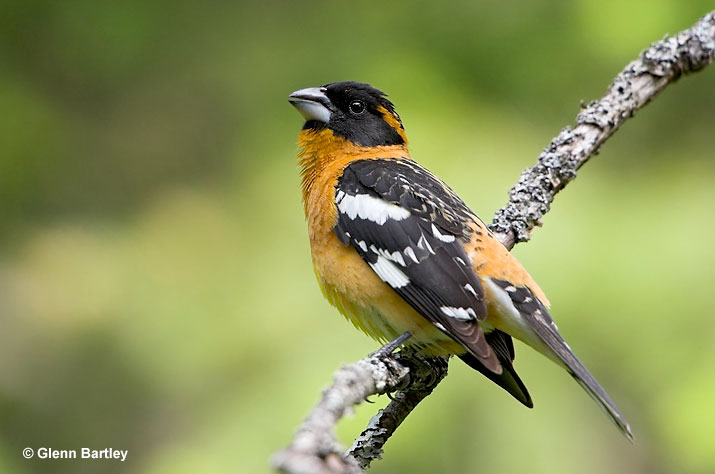
Black-headed Grosbeaks breed across the western United States and southernmost western Canada. Males are a stunning combination of orange-cinnamon, black, and white. Females are brown above, warm buffy to cinnamon below, especially on the throat and breast.
They have a white stripe above their eyes and may have brown streaking along the flanks and chest. Rose-breasted Grosbeaks usually have more streaking on their underside and a pinkish instead of a grayish bill.
Purple Finch
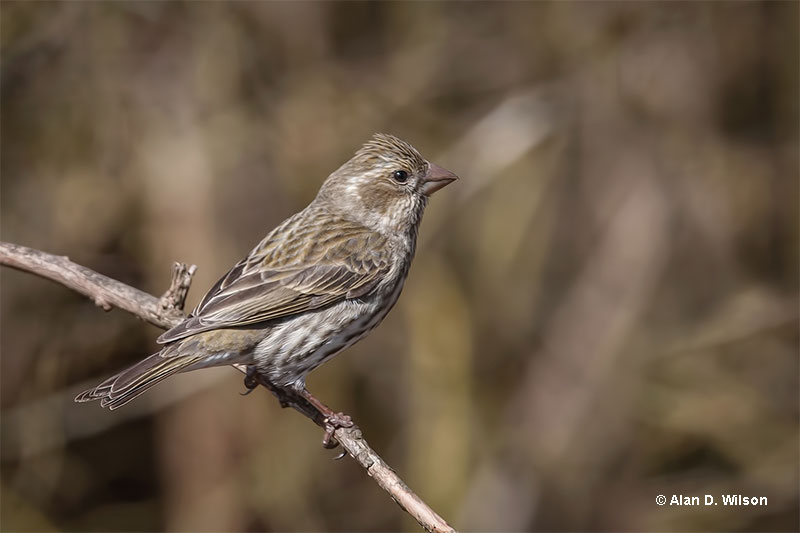
Purple Finches mostly breed in Canada, winter in the eastern United States, and have year-round populations along the west coast and in northeastern North America.
Males have an overall raspberry-red coloring which is richest on the head and breast and mixed with brown on the back. Their bellies are white and their wings are dark. Females are olive-brown to brown on the back, whitish below with dark streaks, and a whitish line above the eye.
Compared to Purple Finches, female Rose-breasted Grosbeaks are larger, have a more defined eyebrow, and have a warm buffy underside with streaks on chest and flanks instead of a white and more streaked underside.
Frequently Asked Questions
How big are Rose-breasted Grosbeaks?
Rose-breasted Grosbeaks are medium-sized songbirds, measuring 7.1-8.7 inches long.
What bird is similar to the Rose-breasted Grosbeak?
Female Black-headed Grosbeaks and female Purple Finches are similar to female Rose-breasted Grosbeaks.
Where do Rose-breasted Grosbeaks live?
In North America, Rose-breasted Grosbeaks live in moist semi-open deciduous or mixed woods across most of Canada and the northeastern United States.
How rare is it to see a Rose-breasted Grosbeak?
Rose-breasted Grosbeaks are fairly common throughout their range.
What does it mean when you see a Rose-breasted Grosbeak?
Seeing a Rose-breasted Grosbeak is a reminder to focus on the matters of your heart. Heal yourself and find forgiveness to move forward.

